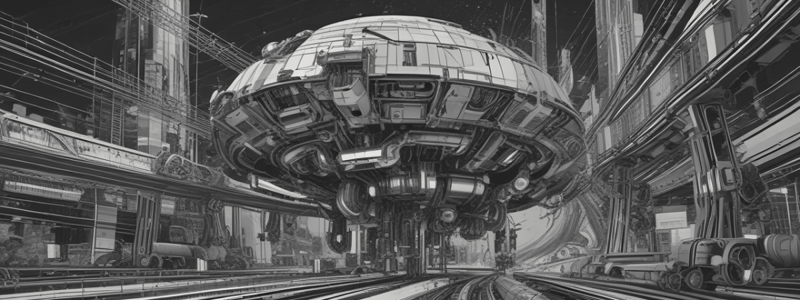Podcast
Questions and Answers
What is the primary cause of prediction error due to bias?
What is the primary cause of prediction error due to bias?
- The model's predictions are significantly varied.
- The model consistently predicts values that differ from the correct values. (correct)
- The model over-fits the training data.
- The model fails to utilize data appropriately.
What does variance measure in the context of prediction models?
What does variance measure in the context of prediction models?
- The range of predictions for a specific data point across multiple model realizations. (correct)
- The average error of the predictions.
- The consistency of predictions across different data sets.
- The degree of randomness in the model's data.
How can bias and variance impact the performance of prediction models?
How can bias and variance impact the performance of prediction models?
- They do not affect model performance at all.
- They only concern theoretical model function without practical implications.
- They provide insights into the optimization of model parameters.
- They lead to a clear understanding of overfitting and underfitting phenomena. (correct)
In the bulls-eye diagram, what does the center represent?
In the bulls-eye diagram, what does the center represent?
What happens to the prediction error if a model has high bias?
What happens to the prediction error if a model has high bias?
Which scenario describes high variance in a prediction model?
Which scenario describes high variance in a prediction model?
Why is understanding both bias and variance important for model fitting?
Why is understanding both bias and variance important for model fitting?
What does a model with low bias but high variance indicate?
What does a model with low bias but high variance indicate?
What does the equation $Y=f(X)+ϵ$ represent in the context of modeling?
What does the equation $Y=f(X)+ϵ$ represent in the context of modeling?
Which component of the prediction error $Err(x)$ accounts for noise that cannot be reduced by any model?
Which component of the prediction error $Err(x)$ accounts for noise that cannot be reduced by any model?
In the scenario described, one source of bias was the use of which sampling method?
In the scenario described, one source of bias was the use of which sampling method?
What happens to both bias and variance if we have infinite data to calibrate our model?
What happens to both bias and variance if we have infinite data to calibrate our model?
What common mistake was highlighted regarding the small sample size in the voting example?
What common mistake was highlighted regarding the small sample size in the voting example?
How is prediction error $Err(x)$ mathematically decomposed?
How is prediction error $Err(x)$ mathematically decomposed?
What did the error in predicting the election outcome largely stem from?
What did the error in predicting the election outcome largely stem from?
Why is the tradeoff between bias and variance significant in model building?
Why is the tradeoff between bias and variance significant in model building?
What is a result of using a model with high bias?
What is a result of using a model with high bias?
When predicting outcomes, how does high variance typically manifest?
When predicting outcomes, how does high variance typically manifest?
What happens to the prediction curves as the value of k increases?
What happens to the prediction curves as the value of k increases?
What is the primary consequence of setting a very large k value in k-Nearest Neighbors?
What is the primary consequence of setting a very large k value in k-Nearest Neighbors?
What does increasing k in a k-Nearest Neighbors model typically do to variance?
What does increasing k in a k-Nearest Neighbors model typically do to variance?
What is a common misunderstanding about managing bias and variance?
What is a common misunderstanding about managing bias and variance?
In the context of k-Nearest Neighbors, what does high variance imply?
In the context of k-Nearest Neighbors, what does high variance imply?
What effect do bagging and resampling techniques have on variance?
What effect do bagging and resampling techniques have on variance?
What role does k play in affecting the 'islands' of data in k-Nearest Neighbors?
What role does k play in affecting the 'islands' of data in k-Nearest Neighbors?
What is the relationship between bias and variance in terms of model error?
What is the relationship between bias and variance in terms of model error?
What is one expression for total error in a k-Nearest Neighbors model?
What is one expression for total error in a k-Nearest Neighbors model?
What does the roughness of the model space influence?
What does the roughness of the model space influence?
How does increasing the sample size affect the scatter of estimates in predictions?
How does increasing the sample size affect the scatter of estimates in predictions?
What is one consequence of the tradeoff between bias and variance when building a model?
What is one consequence of the tradeoff between bias and variance when building a model?
For predicting voter registration in the k-Nearest Neighbors algorithm, which factors are primarily used?
For predicting voter registration in the k-Nearest Neighbors algorithm, which factors are primarily used?
What happens to the prediction in k-Nearest Neighbors as the value of k increases?
What happens to the prediction in k-Nearest Neighbors as the value of k increases?
In the context of the k-Nearest Neighbors algorithm, what does plotting the points of new voters help illustrate?
In the context of the k-Nearest Neighbors algorithm, what does plotting the points of new voters help illustrate?
What does the bulls-eye diagram signify in the discussion of sample size and predictions?
What does the bulls-eye diagram signify in the discussion of sample size and predictions?
Which method is commonly used for binary data like voter registration?
Which method is commonly used for binary data like voter registration?
Why might k-Nearest Neighbors be chosen over logistic regression?
Why might k-Nearest Neighbors be chosen over logistic regression?
What does a high value of k in the k-Nearest Neighbors algorithm typically result in?
What does a high value of k in the k-Nearest Neighbors algorithm typically result in?
What is an inherent limitation of simply increasing sample size in/model development?
What is an inherent limitation of simply increasing sample size in/model development?
What is the primary purpose of creating an ensemble of models?
What is the primary purpose of creating an ensemble of models?
How does the variance of a Random Forest model compare to that of a single decision tree?
How does the variance of a Random Forest model compare to that of a single decision tree?
What happens to the model's bias as the training sample size approaches infinity?
What happens to the model's bias as the training sample size approaches infinity?
What does an asymptotically efficient model guarantee?
What does an asymptotically efficient model guarantee?
What is the relationship between model complexity and bias?
What is the relationship between model complexity and bias?
What is meant by the 'sweet spot' in model complexity?
What is meant by the 'sweet spot' in model complexity?
What is a potential issue when using theoretical error measures?
What is a potential issue when using theoretical error measures?
What occurs if a model's complexity exceeds the sweet spot?
What occurs if a model's complexity exceeds the sweet spot?
Which of the following accurately describes variance in the context of model complexity?
Which of the following accurately describes variance in the context of model complexity?
What do we mean by over-fitting a model?
What do we mean by over-fitting a model?
Flashcards are hidden until you start studying
Study Notes
Bias-Variance Tradeoff
- Prediction errors can be split into two components: bias and variance, both impacting model performance.
- Understanding bias and variance increases model accuracy and helps prevent overfitting (high variance) and underfitting (high bias).
Definitions of Bias and Variance
- Bias: The difference between the average predictions of a model and the actual values. High bias can lead to systematic errors regardless of the training data.
- Variance: The variability of model predictions for a given data point across different model realizations. High variance means predictions fluctuate significantly.
Conceptual Visualization
- A bulls-eye diagram can illustrate the performance of models. The center represents perfect predictions, while scattered points show differing prediction accuracies.
- Cases of low/high bias and variance exhibit different degrees of closeness to the bulls-eye and scatter among predictions.
Mathematical Decomposition
- Prediction error can be mathematically expressed as:
- Err(x) = E[(Y - f̂(x))²] = (E[f̂(x)] - f(x))² + E[(f̂(x) - E[f̂(x)])²] + σ²e.
- This breaks down into:
- Total Error = Bias² + Variance + Irreducible Error (the noise that cannot be reduced).
Example: Voting Intentions
- A flawed model predicting votes from a small, biased sample (random phone book selection) led to inaccurate results.
- Issues causing bias: non-representative sampling and lack of follow-up on non-respondents.
- A small sample size introduces variance, as predictions become less consistent.
- Emphasizes the tradeoff: reducing bias may increase variance and vice versa.
Refined Example: Voter Party Registration
- A simulated dataset includes voter party registration, wealth, and religiousness used for prediction.
- k-Nearest Neighbors (k-NN) is introduced as a flexible technique for such modeling.
- The choice of 'k' significantly impacts bias and variance:
- Lower 'k' (e.g., 1) increases variance with jagged prediction boundaries.
- Higher 'k' smooths predictions but can lead to higher bias as it ignores locally relevant data.
Managing Bias and Variance
- Minimizing bias at the expense of increased variance is a common misconception; both should be balanced.
- Bagging is a technique used to reduce variance:
- Involves creating multiple datasets via bootstrapping and aggregating the predictions.
- Random Forests exemplifies this method, averaging decisions across numerous trees to minimize variance.
Asymptotic Properties
- As sample size increases, models ideally exhibit asymptotic properties:
- Bias approaches zero (asymptotic consistency).
- Variance does not exceed other possible models (asymptotic efficiency).
- Real-world applications may differ, especially with small datasets, where simpler algorithms might outperform.
Overfitting and Underfitting
- The balance of bias and variance relates directly to model complexity.
- Increased complexity (more parameters) generally reduces bias but can increase variance, leading to overfitting.
- Conversely, too simplistic a model results in high bias and underfitting.
- Finding the "sweet spot" where the increase in bias corresponds to a decrease in variance is crucial for optimal model performance.
Error Measurement
- Accurate measures of overall error are vital; resampling techniques like cross-validation are preferred over theoretical measures.
- Selecting correct error metrics ensures better assessment of model performance in real-world scenarios.
Studying That Suits You
Use AI to generate personalized quizzes and flashcards to suit your learning preferences.




